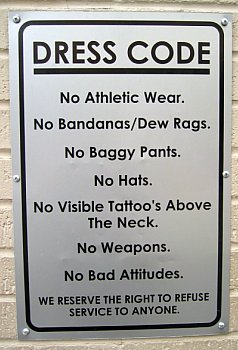

Television has a big impact on how we see the different classes in our society. In the video "class dismissed", these different views on class level are discussed. Television has many ways of twisting our views of the working and middle class in everday life, to make these classes seem less or more glamorous than they really are.
One of the points touched upon in the video was that class matters, even if we may not think so. It was said that many people reject the fact that they are working class, so they don't have a sense of class conciousness. I've never run into someone like that, at least not that I'm aware of. Most people who are in the working class know what class they are in, but are willing to work hard to try and get to a better situation for them. When people do not have a sense of class conciousness, this can cause conflict within classes. I imagine it would lead to unevenness within social classes. Even though, within our social classes, we are all generally equal, some may still think they are higher up than others. It would only make sense that this would create competition within the social classes, which in turn can be good for society, so people are motivated to move up within their class or to a different class. Of course, like the video also said, there will always be a working class as long as we have the system of capitalism.
The video also talked about the American Dream Machine. The American dream machine is, in a sense, having the perfect home and being in the middle/upper class. Many times, this american dream machine is associated with certain products and things around the home. Therefore, when people can afford these items, they believe that they can become part of that middle/upper class. However, this doesn't make sense if you think about it. Just because you have certain products, doesn't mean that you are middle or upper class, it just means you have those products.
Over the years, different races have also made their way to television and have become very much a part of everyday television. When black T.V. shows first aired, most of them were about black families living in the ghettos or in the projects. As time went on, they became more everday families, like the Cosby Show. Over the years, it has shown that African Americans are hard working people, and depicts them as the ones that will rise to the top from nothing in our society. African American based shows began airing after the Civil Rights era. During this time, many white people were still bitter towards black people. Because of this, the shows depicted blacks as people who didn't have the privelege of living in a nice neighborhood with a good home and a good environment to grow up in. As blacks became more accepted throughout society over the years, they were seen more as equals and people realized that they could make it on their own, just like any other race.
In the 1950's and 60's, the role women played in T.V. shows was usually the stay at home mom, or the house wife. Usually the husband or father worked in a working class environment, yet the families always had a nice house and lived in a good neighborhood. In most T.V. shows, the jobs or women or the pay is unclear, and we automatically assume they have a good job because of how their lives are depicted. In reality, many women have working class jobs in factories or offices. The women we see in real life for the most part are not who most are on T.V.
T.V. can twist our views of how the working and middle class are portrayed. Most of the time, the way it is depicted on T.V. is not how it is in real life.










